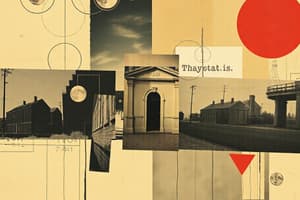Podcast
Questions and Answers
What is the name of the political group that opposed industrialization in Russia?
What is the name of the political group that opposed industrialization in Russia?
The Populist
Who assassinated Tzar Alexander II?
Who assassinated Tzar Alexander II?
Sofia Perovskaia
What event occurred on Bloody Sunday?
What event occurred on Bloody Sunday?
Tsar's guards shot at peaceful demonstrators asking for economic reform.
The October Manifesto by Nicholas II established a fully fledged constitutional government in Russia.
The October Manifesto by Nicholas II established a fully fledged constitutional government in Russia.
What is the name of the council of workers elected to represent workers' interests?
What is the name of the council of workers elected to represent workers' interests?
The "Fundamental Laws of 1906" established a fully constitutional monarchy in Russia.
The "Fundamental Laws of 1906" established a fully constitutional monarchy in Russia.
Who was the Russian poet known for his symbolic style?
Who was the Russian poet known for his symbolic style?
Who is the Russian poet known for his work in the style of Russian modernism, characterized by themes of mythicism and spirituality?
Who is the Russian poet known for his work in the style of Russian modernism, characterized by themes of mythicism and spirituality?
What is the name of the Russian poet who is considered the founder of Russian Futurism?
What is the name of the Russian poet who is considered the founder of Russian Futurism?
The term "Acmesim" is associated with which art movement?
The term "Acmesim" is associated with which art movement?
What was the name of the art movement that emerged with the Russian Revolution in 1920, and emphasized functionality and used photo-montage or collages?
What was the name of the art movement that emerged with the Russian Revolution in 1920, and emphasized functionality and used photo-montage or collages?
Who was the prominent proponent of "Neo-Primitivism" in Russian art?
Who was the prominent proponent of "Neo-Primitivism" in Russian art?
Who is the Russian artist known for his work in Suprematism, a movement that explored pure geometric forms?
Who is the Russian artist known for his work in Suprematism, a movement that explored pure geometric forms?
What was the name of the art movement that was a reaction to the chaos of the revolution, focused on word-crafting and precision?
What was the name of the art movement that was a reaction to the chaos of the revolution, focused on word-crafting and precision?
What was the name of the organization that was created to promote working-class art during the revolution?
What was the name of the organization that was created to promote working-class art during the revolution?
Who was the head of the provisional government in Russia during the revolution?
Who was the head of the provisional government in Russia during the revolution?
The Bolsheviks seized power in a non-violent manner during the October Revolution.
The Bolsheviks seized power in a non-violent manner during the October Revolution.
Who was the leader of the Red Guards, which were a group of armed workers who helped the Bolsheviks during the October Revolution?
Who was the leader of the Red Guards, which were a group of armed workers who helped the Bolsheviks during the October Revolution?
What were the two key slogans used by Lenin to appeal to the working class during the revolution?
What were the two key slogans used by Lenin to appeal to the working class during the revolution?
Flashcards
What did Churchill want to do to the Bolsheviks?
What did Churchill want to do to the Bolsheviks?
Winston Churchill, a British politician at the time, was strongly opposed to the Bolsheviks (Russian communists) and advocated for a full-scale military attack on them. He believed they were a threat to the world order and the interests of Britain.
What did the White Army represent?
What did the White Army represent?
The White Army was a collection of anti-Bolshevik forces during the Russian Civil War. They were mainly composed of former Tsarist generals, officers, and soldiers who opposed the communist regime and sought to restore the Tsarist order.
What was the 'People's Will'?
What was the 'People's Will'?
The 'People's Will' was a terrorist wing of the Russian populist movement. They believed in using violence to overthrow the Tsarist regime and establish a socialist society.
What was the significance of Bloody Sunday?
What was the significance of Bloody Sunday?
Signup and view all the flashcards
What was the October Manifesto?
What was the October Manifesto?
Signup and view all the flashcards
What was the Duma?
What was the Duma?
Signup and view all the flashcards
Who was Rasputin?
Who was Rasputin?
Signup and view all the flashcards
What was the role of the Petrograd Soviet?
What was the role of the Petrograd Soviet?
Signup and view all the flashcards
What were Lenin's main slogans?
What were Lenin's main slogans?
Signup and view all the flashcards
What was the significance of October 24/25, 1917?
What was the significance of October 24/25, 1917?
Signup and view all the flashcards
What was the significance of the 'All Power to the Soviets' slogan?
What was the significance of the 'All Power to the Soviets' slogan?
Signup and view all the flashcards
What was the 'July Days'?
What was the 'July Days'?
Signup and view all the flashcards
What was the significance of the Lavr Kornilov coup attempt?
What was the significance of the Lavr Kornilov coup attempt?
Signup and view all the flashcards
What was the Cheka?
What was the Cheka?
Signup and view all the flashcards
What was 'War Communism'?
What was 'War Communism'?
Signup and view all the flashcards
What was the NEP?
What was the NEP?
Signup and view all the flashcards
Who was Alexander Kerensky?
Who was Alexander Kerensky?
Signup and view all the flashcards
What was the 'Silver Age of Poetry'?
What was the 'Silver Age of Poetry'?
Signup and view all the flashcards
What was Symbolism in Russian poetry?
What was Symbolism in Russian poetry?
Signup and view all the flashcards
What was Futurism in Russian poetry?
What was Futurism in Russian poetry?
Signup and view all the flashcards
What was Acmeism in Russian poetry?
What was Acmeism in Russian poetry?
Signup and view all the flashcards
What was the significance of the 'Proletkult'?
What was the significance of the 'Proletkult'?
Signup and view all the flashcards
What was the significance of 'Communal Apartments'?
What was the significance of 'Communal Apartments'?
Signup and view all the flashcards
What was the significance of the 'Red Cavalry' campaign?
What was the significance of the 'Red Cavalry' campaign?
Signup and view all the flashcards
What was the Soviet Man?
What was the Soviet Man?
Signup and view all the flashcards
What was the 'Stakhanovite' movement?
What was the 'Stakhanovite' movement?
Signup and view all the flashcards
What was the significance of 'Zhenotdel'?
What was the significance of 'Zhenotdel'?
Signup and view all the flashcards
What was the significance of the 'Rabfaki'?
What was the significance of the 'Rabfaki'?
Signup and view all the flashcards
What was the significance of the 'Golden Age of Russian Film'?
What was the significance of the 'Golden Age of Russian Film'?
Signup and view all the flashcards
What was the significance of the 'Montage of Attractions' technique?
What was the significance of the 'Montage of Attractions' technique?
Signup and view all the flashcards
What was the significance of 'We' by Evgeny Zamyatin?
What was the significance of 'We' by Evgeny Zamyatin?
Signup and view all the flashcards
What was the significance of the 'Komsomol'?
What was the significance of the 'Komsomol'?
Signup and view all the flashcards
Study Notes
Summary of General Information
- No specific text or file provided for summary. Please provide the relevant information.
Studying That Suits You
Use AI to generate personalized quizzes and flashcards to suit your learning preferences.



